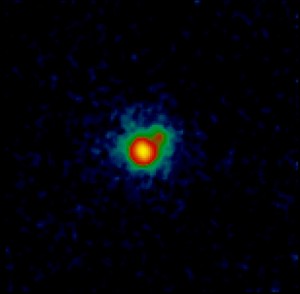Mauna Kea’s Keck Observatory and the Canada-France-Hawai’i Telescope have found a new candidate for the coldest known star in existance: a brown dwarf that scientists say has the same temperature as a hot cup of coffee.
That’s cool enough to begin crossing the blurry line between small cold stars and big hot planets.
The psuedo-star is the smaller and dimmer member of a binary brown dwarf system located just 75 light-years from Earth.
The researchers are reporting their discovery in an upcoming issue of Astrophysical Journal.
From the media release:
New Candidate For Coldest ‘Star’
Kamuela, HI – There is a new candidate for coldest known star: a brown dwarf with about the same temperature as a hot cup of coffee. That’s cool enough to begin crossing the blurry line between small cold stars and big hot planets.
Brown dwarfs are essentially failed stars: they lack the mass and gravity to trigger the nuclear reactions that make stars shine brightly. The newly discovered brown dwarf, identified as CFBDSIR 1458+10B, is the smaller and dimmer member of a binary brown dwarf system located just 75 light-years from Earth. The pair was discovered by astronomers using the W. M. Keck Observatory and the Canada-France-Hawai’i Telescope (CFHT), both on the summit of Mauna Kea in Hawai’i, following up on earlier work done at European Southern Observatory’s Very Large Telescope in Chile.
The lesser dwarf has a temperature of 370 K, plus or minus 40 K. That translates into about 200 degrees F (100 degrees C) – right around the boiling point of water on Earth’s surface.
“At such temperatures, we expect the brown dwarf has properties that are unique from previously known brown dwarfs and much closer to cold exoplanets, such as the presence of water clouds in its atmosphere,” said Michael Liu of the University of Hawai’i’s Institute for Astronomy. “In fact, once we start taking images of gas-giant planets around Sun-like stars in the near-future, I expect that many of them will look like CFBDSIR 1458+10B.”
The researchers are reporting their discovery in an upcoming issue of Astrophysical Journal. Their paper is available online at http://arxiv.org/abs/1103.0014.
CFBDSIR 1458+10B was detected using the Laser Guide Star (LGS) Adaptive Optics system on the Keck II Telescope. Adaptive Optics essentially cancels out much of Earth’s atmospheric interference.
“The binary was resolved with Keck LGS Adaptive Optics imaging, and in fact can only be done with Keck LGS, given the difficulty of the measurement,” said Liu. The double dwarfs were confirmed as a linked pair by two measurements which showed the objects are moving together.
Liu and his colleagues employed the CFHT to determine the distance to the brown dwarf duo – an essential step for interpreting what they observed with the Keck II Telescope. CFHT’s wide-field near-IR camera, WIRCam, allowed astronomers to use the apparent motion of more distant stars behind the brown dwarfs, caused by Earth’s changing position in its orbit around the Sun, to determine the distance to the brown dwarfs.
“This ‘leap forward’ was made possible through the combination of both Keck and CFHT data, taking advantage of the unique instrumentation available on each,” said Trent Dupuy, former University of Hawai’i graduate student, now at the Harvard-Smithsonian Center for Astrophysics, and a coauthor of the paper.
The CFBDSIR 1458+10 system was originally announced last year, but it was believed to be only a single object. Observations with the European Southern Observatory’s Very Large Telescope indicated the combined system had a very low temperature, making it probably the third coolest object to date.
“We were very excited originally to see this object had such a low temperature, but we never guessed that it would turn out to be a binary star and have an even more interesting, even colder companion,” said Philippe Delorme of the University of Grenoble, another coauthor of the paper.
The Spitzer Space Telescope has recently identified two other, very faint objects as other possible contenders for the coolest known objects, though their temperatures are less well-constrained. Future observations will better determine how these objects compare to CFBDSIR 1458+10B.
Liu and his colleagues are planning to observe CFBDSIR 1458+10B in the future to better determine its properties and to begin mapping the binary’s orbit. For the latter, about a decade of monitoring should allow astronomers to even weigh the binary’s mass.
Other coauthors on the paper are Brendan P. Bowler, Loic Albert, Etienne Artigau, Celine Reyle, Thierry Forveille and Xavier Delfosse.
The W. M. Keck Observatory operates two 10-meter optical/infrared telescopes on the summit of Mauna Kea. The Observatory is a private 501(c) 3 organization and a scientific partnership of the California Institute of Technology, the University of California and NASA.


by Big Island Video News8:30 pm
on at
STORY SUMMARY
Voice of Stephanie Salazar Mauna Kea’s Keck Observatory and the Canada-France-Hawai’i Telescope have found a new candidate for the coldest known star in existance: a brown dwarf that scientists say has the same temperature as a hot cup of coffee. That’s cool enough to begin crossing the blurry line between small cold stars and big […]